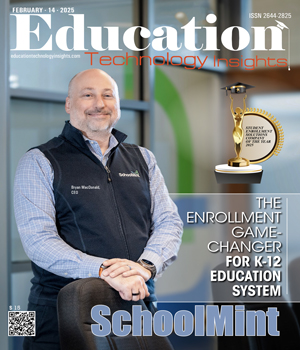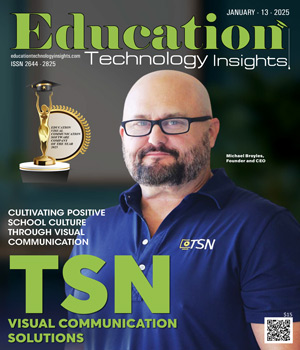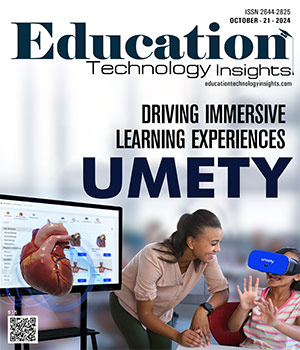THANK YOU FOR SUBSCRIBING
Be first to read the latest tech news, Industry Leader's Insights, and CIO interviews of medium and large enterprises exclusively from Education Technology Insights
Empowering Faculty Through Tech and Training
John C. Bansavich Ed.D., Interim Director, Educational Technology Services, the University of San Francisco (USF)
 John C. Bansavich Ed.D., Interim Director, Educational Technology Services, the University of San Francisco (USF)
John C. Bansavich Ed.D., Interim Director, Educational Technology Services, the University of San Francisco (USF)John C. Bansavich Ed.D. has been working at USF since 1997 and is currently the Interim Director of Educational Technology Services. John is also Adjunct faculty in the Educational Technology Masters (MA) Program, in the School of Education at USF. John has taught courses in Web Design and Issues, Trends, and Research for the program, as well as Teaching, Learning, and Technology for the Teacher Education Department. He earned his Ed.D. from the USF School of Education's Learning and Instruction Department.
In an exclusive interview with Educational Technology Insights, he shared his invaluable insights on the use of technology in education and the challenges of integration.
Key Roles and Responsibilities
I have been working for 28 years in educational technology at the University of San Francisco. I oversee a team within Educational Technology Services, which consists of four senior instructional technologists responsible for training and support. Their primary responsibility is to train and support faculty, staff, and occasionally students on commonly used instructional technologies in higher education.
Within Educational Technology Services (ETS), there are three core groups: Instructional Technology and Training, which focuses on faculty and staff training and support; Learning Spaces Engineering, which is responsible for the design and build-out of classrooms; and Media Services, which handle video production, classroom recording, and event streaming. Those are the main areas my team and I manage and support.
I also work closely with our Associate Director of Learning Spaces Engineering. He oversees the design and specification of new classroom and conference room builds. He also manages a small team of videographers in our media services department.
Integrated Educational Technologies and Faculty Support
We utilize a variety of tools to enhance teaching at the university. For instance, as a Canvas school, we have a dedicated staff member who works with faculty on Canvas use, training, and support. We have another staff member who specializes in Panopto, our video management tool, and supports individuals using Zoom.
We have another individual who assists staff with the use of Simple Syllabus, a tool we onboarded several years ago to standardize syllabi and facilitate format and distribution. Qualtrics is a widely used tool for creating and distributing surveys.
“It’s about being proactive, staying on the cutting edge, and translating what we are learning into clear communication and practical support for our communities. It's about lifelong learning together, adapting together, and helping others navigate what’s ahead”
LinkedIn Learning is a web-based tutorial tool to help faculty, staff, and students with their use of technology and professional development. Our faculty and staff utilize Slack, and we provide them with training on how to effectively manage their accounts. We also use Gradescope and Turnitin. Gradescope is very useful for faculty in the grading process, as it helps automate grading and saves a significant amount of time. Turnitin is a plagiarism detection tool that is also now being used for AI detection.
During lockdown, we implemented Respondus LockDown Browser Monitor, which helps to ensure secure testing in the classroom and remotely. We use Hypothesis for collaborative social annotation and Poll Everywhere for classroom engagement tools. We have another staff member who assists our staff and faculty with web page development and electronic newsletter creation and distribution.
We strive to integrate our technologies with Canvas, allowing instructors to access these tools directly through Canvas. That's our primary learning management system, and faculty can incorporate these learning tools into the Canvas courses they teach semester by semester. Most of our learning platforms incorporate single sign-in, so faculty, staff, and students don't have to remember another password and username.
Fostering AI Literacy and Support in Education
One of our primary challenges is the adoption of teaching and learning tools, including GenAI awareness and literacy among faculty members, and ensuring they receive proper training. We accept everyone where they are, but most of our faculty are receptive. However, they also have many questions about academic integrity and how they can support students on this journey.
We are closely monitoring developments in generative AI, particularly in its applications for automating tasks, assisting with student work, and enhancing learning environments. Students are savvy, and as technology advances, our challenge is to ensure that authentic learning continues to take place.
While AI is a powerful tool that can help brainstorming and outlining activities, it can also write entire papers, so we must ensure students are learning the material and demonstrating their understanding. That means supporting faculty in monitoring and guiding AI use, not out of fear, but from an informed and balanced perspective.
We have developed guidelines that we share with instructors when we are teaching them about generative AI, which they can adopt and share with their students. One of the strategies we have developed is to include three syllabus statements, providing instructors with guidance on how to effectively communicate the use of generative AI in their courses. The faculty can choose one of the three options or create a modified version of one of them that meets the course's needs.
We have focused on building AI literacy and capacity through professional development. One of our key initiatives is a certification program we launched last year. Faculty attend five workshops, complete a final project, and receive a certificate issued by our department. This helps them build confidence and provides a platform for reflection on their use of AI and how to support students more effectively.
We have also hosted an annual AI symposium. This past April was our second one. It’s a faculty-focused event featuring members of our teaching community who share their experiences using generative AI in the classroom. They participate in panels and discussions about what has worked, what hasn’t, and what other instructors might learn from their use cases. We also invite industry experts to discuss how their products utilize AI and how the broader workforce is evolving so faculty can better prepare students for what lies ahead.
We are in the early days of AI integration in classrooms, whether it’s voice recognition or automated tools for instructors.
Insights for Navigating Change
First and foremost, build a strong network of peers. You are not in this alone. Connect with like-minded individuals who are working on similar projects at other institutions. That kind of network is invaluable for asking questions, exploring tools, and addressing shared challenges.
Second, don’t be afraid of change. In higher education, we are sometimes seen as resistant to change, but in technology, stagnation isn’t an option. This field is constantly evolving, and we must adapt to it. Resilience and openness are key.
Especially with AI, we must approach it with curiosity, not fear. The best thing we can do is stay informed, communicate clearly, and guide our communities through it. As technologists, our role is to investigate, learn, and then help faculty, staff, and students understand the implications, opportunities, and limitations.
It’s about being proactive, staying on the cutting edge, and translating what we are learning into clear communication and practical support for our communities. It's about lifelong learning together, adapting together, and helping others navigate what’s ahead.
Read Also
The Indispensable Role of Emotional Intelligence in K-12 Technology Leadership
Reimagining Learning in a Digital World
Simplifying Online Program Tuition: Residency-Based Pricing in a Digital Age
Empowering the Future of Online Learning: A Holistic Vision for Transformational Education
Transforming Education Through Technology Leadership
Preparing for Generation Alpha in the Age of AI

I agree We use cookies on this website to enhance your user experience. By clicking any link on this page you are giving your consent for us to set cookies. More info















-(2)-1.jpg)











